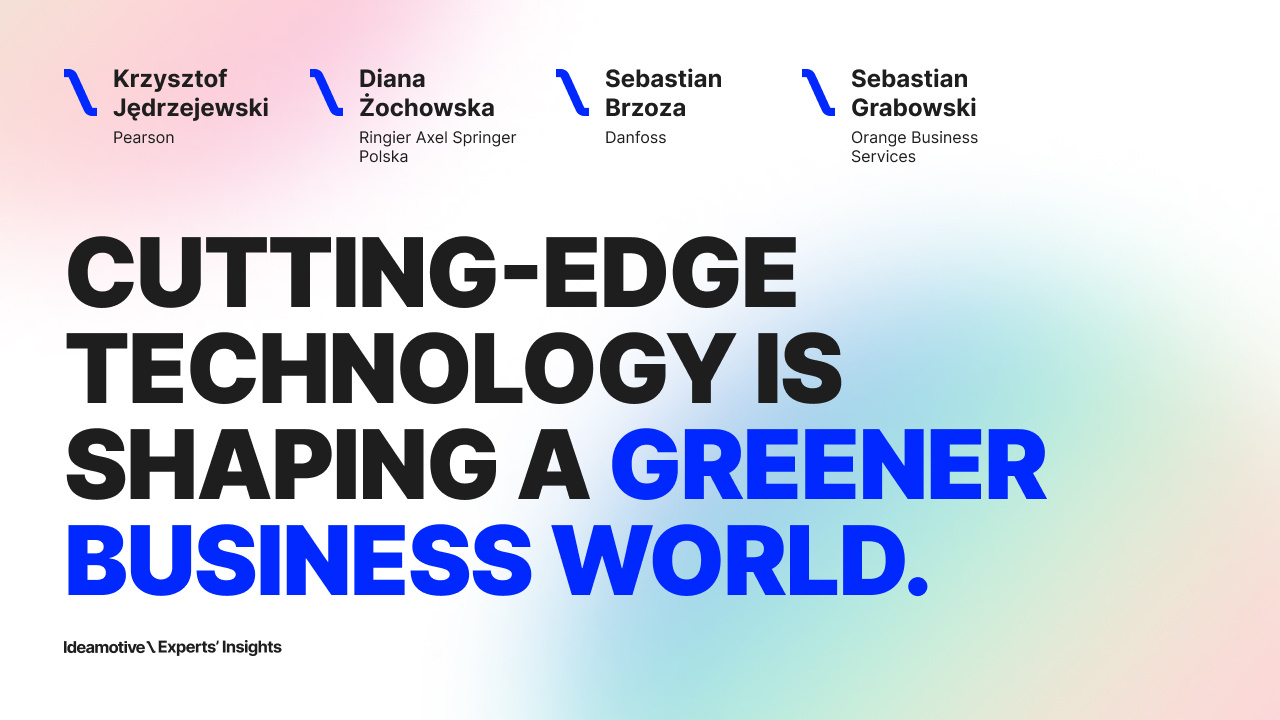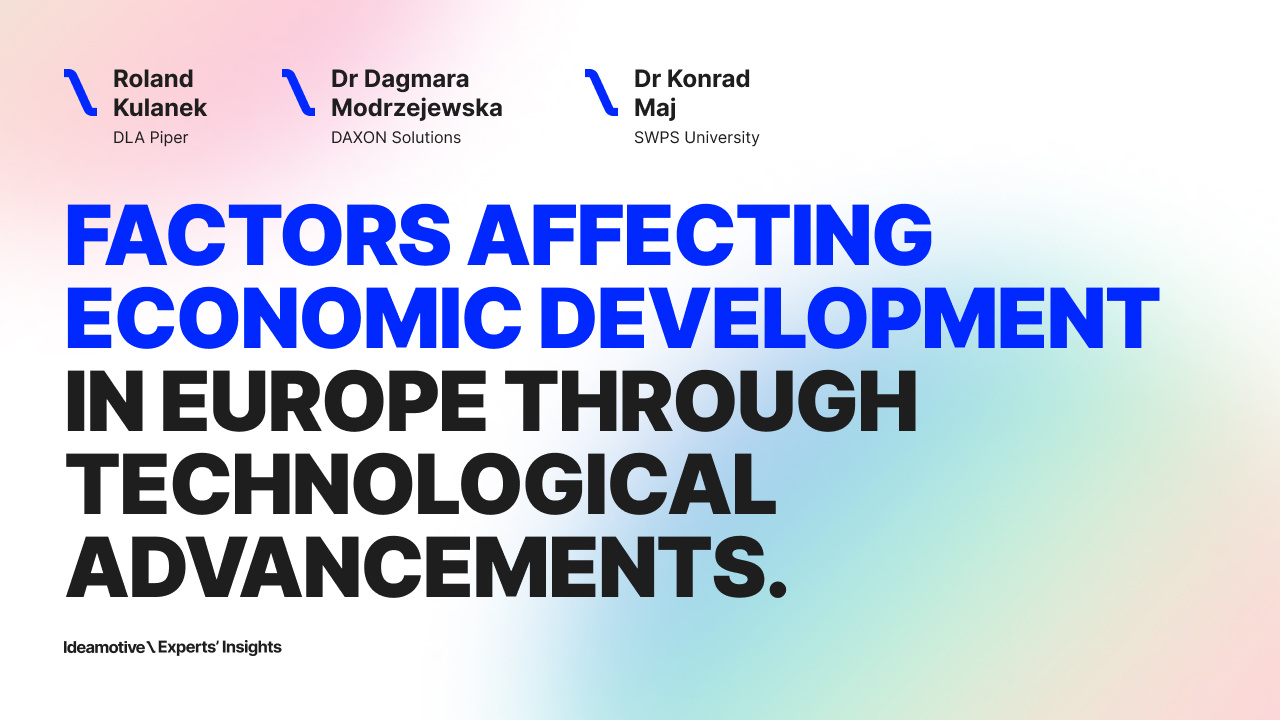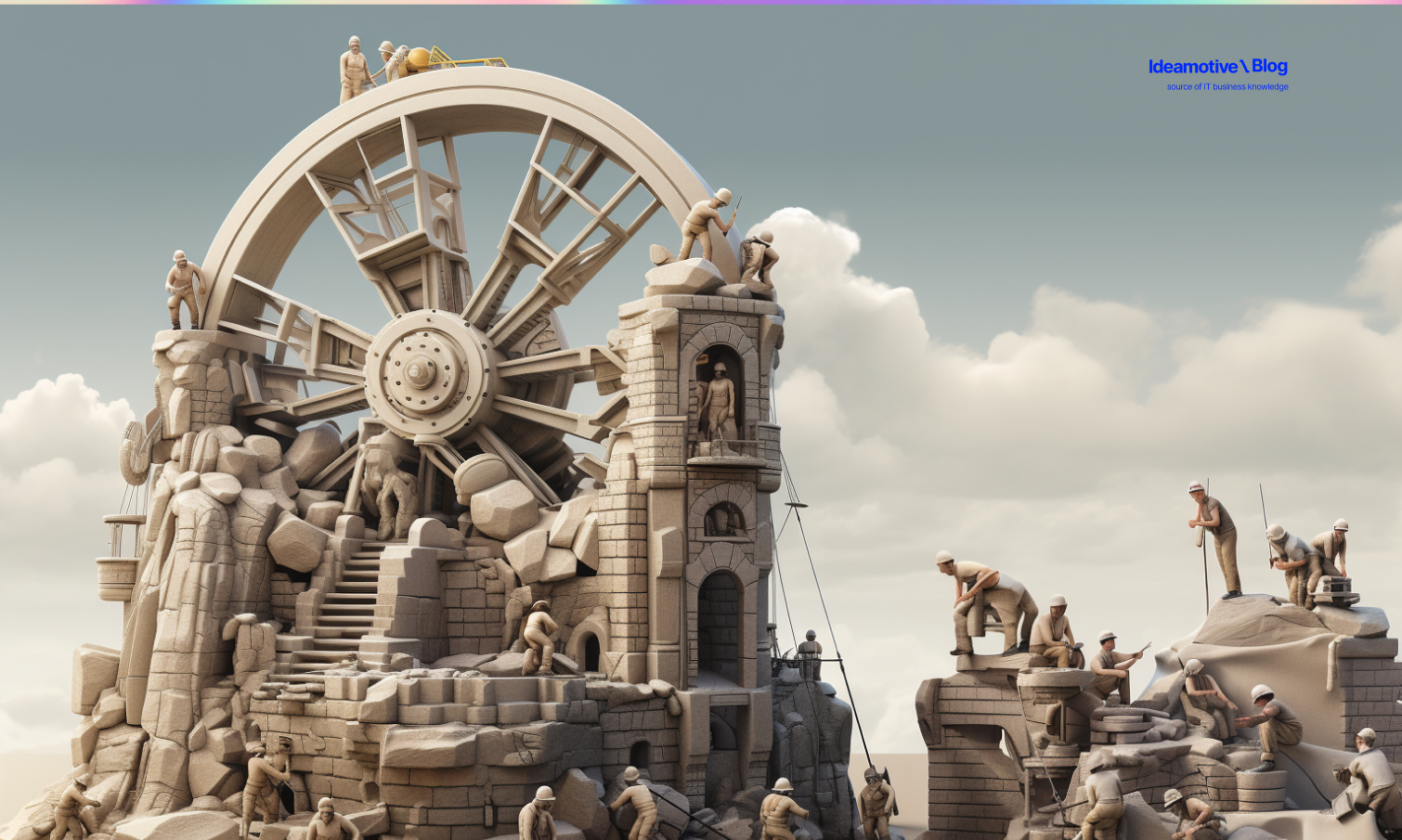Experts' Insights: Cutting-Edge Technology Is Shaping a Greener Business World
Jul 30, 20249 min read

Cezary Dobrowolski
Tech-savvy marketer and futurologist, focused on blockchain and AI's future in software and marketing, while rejecting traditional corporate marketing methods.

We asked top Polish specialists in sustainable development for their insights on the future of ecology in business. Discover how renewable energy, advanced analytics, AI, blockchain, and IoT are transforming corporate sustainability. Dive into real-world examples of companies reducing their carbon footprints and enhancing efficiency. Don’t miss out on insights that could shape the future of your business.
In today’s interconnected world, the relationship between sustainability and development is as intertwined as ever, creating a dynamic ecosystem where every action has far-reaching impacts. Corporate investments in renewable energy, advancements in AI and data analytics, the potential of blockchain, and the integration of IoT technology are all crucial elements driving this transformation. These innovations are not only reducing carbon footprints but also optimizing resource use and creating new economic opportunities.
As you explore this article, you will discover how these technologies are shaping corporate sustainability, with real-world examples of companies leading the charge. The insights provided by Polish executives in sustainable development from top global companies will give you a deeper understanding of the strategies and hard work behind these advancements, showcasing the elite group of professionals who are diligently crafting a better future for us all.
Corporate investments in renewable energy technologies not only reduce carbon footprints but also create new economic opportunities and job markets
The growth of the renewable energy sector is not just a boon for the environment; it’s also a powerful engine for job creation. According to the International Renewable Energy Agency (IRENA), the sector already employed over 12 million people globally in 2022, with projections suggesting a significant increase by 2030. However, the most compelling aspect of this job growth is the demand for highly skilled engineers and specialists.
These cutting-edge professionals are not only driving corporate growth but also elevating the importance of advanced education and specialized training in society. This self-reinforcing cycle results in a generation of higher-skilled individuals who further expand technological advancements, driving economic growth and propelling our collective progress forward. As we continue to embrace and invest in renewable energy, the ripple effects on education, job markets, and technological innovation will only become more pronounced.
What remains to be seen is how corporations and educational institutions will adapt to support and sustain this dynamic development.
Advanced data analytics and AI are key to unlocking new levels of corporate sustainability by optimizing resource use and minimizing waste
One of the biggest challenges for corporations is optimizing resources. As companies scale to colossal sizes, achieving perfect optimization becomes increasingly difficult. Despite decades of effort, many organizations still struggle with inefficiencies. This is where artificial intelligence (AI) comes into play. In 2023 alone, the AI market for supply chain optimization grew by 20%, highlighting its increasing relevance.
AI models enable leveraging a deeper and more comprehensive understanding of dependencies between organizational operations and their business environment, allowing for more precise management of supply chains, reduction of overproduction, elimination of waste, and efficient energy resource management.
For instance, a McKinsey report from 2023 found that companies using AI in their supply chains saw a 15% reduction in logistics costs and a 35% improvement in inventory levels. This is just the beginning of AI's potential to revolutionize resource optimization. The future holds even more surprising advancements, as AI continues to evolve and integrate into various aspects of corporate operations.
“While the rapid advancement of AI, particularly generative AI, raises concerns about its substantial computational demands and potential threat to sustainable development, the evolution of small language models offers a promising solution. As research progresses, I anticipate that smaller models, such as those with just 7 billion parameters, may relatively soon rival the capabilities of today's largest models like GPT-4 or LLaMA3 400B. However, we need not wait for future breakthroughs to reap the benefits. By leveraging existing small language models, fine-tuning techniques, and methods like retrieval-augmented generation (RAG), organizations can already achieve comparable performance for most tasks while significantly reducing energy consumption. This approach not only translates to cost savings but also substantially lowers the carbon footprint of AI applications, paving the way for more sustainable and accessible artificial intelligence.”
Potential of Merging Blockchain with Ecological Responsibility
Despite blockchain technology's current shortcomings in terms of carbon neutrality, its potential for sustainability remains promising. The initial vision of Bitcoin's creator(s) has shifted, transforming cryptocurrencies from a decentralized alternative to cash into a more centralized payment method. The ambitious ideas combining blockchain with ecological initiatives have often been leveraged as marketing tools by entrepreneurs seeking rapid growth with minimal effort.
However, there are emerging applications of blockchain that genuinely aim to enhance corporate sustainability. For instance, projects like the Energy Web Foundation are utilizing blockchain to manage decentralized energy grids, increasing efficiency and reducing emissions. A 2023 report by the World Economic Forum highlighted blockchain's potential in supply chain transparency, which could lead to more sustainable practices across industries. As the technology matures and the hype settles, we may see more realistic and impactful blockchain applications in corporate sustainability.
It's worth mentioning Gartner's Hype Cycle, specifically the Plateau of Productivity, which blockchain technology appears to be approaching, if not already on. This phase is where the technology begins to find its practical and sustainable uses, moving beyond inflated expectations and initial disappointments. Blockchain's trajectory towards this plateau signals a maturation that could bring forth more reliable and impactful applications, particularly in the realm of corporate sustainability. As startups navigate this evolving landscape, those focusing on genuine, scalable solutions are likely to spearhead the integration of blockchain with ecological responsibility, setting new standards for sustainability in various sectors.
The question remains: how will these technologies evolve, and which startups will lead the way in merging blockchain with ecological responsibility?
Digital transformation initiatives lead to significant reductions in carbon emissions.
Digital transformation initiatives lead to significant reductions in carbon emissions by leveraging advanced technologies to optimize operations and reduce resource usage. Digital tools and platforms help companies cut down on physical infrastructure and commuting. For instance, a 2024 study by Stanford University shows that remote work could lower global emissions by 54 million metric tons per year.
Companies like Microsoft have reduced their carbon footprint by nearly 30% in the past two years by moving to a digital workspace. Similarly, Siemens reported a 20% drop in energy use after adopting IoT and digital twin technologies. Beyond remote work, other digital transformation initiatives also play a significant role. For instance, adopting cloud computing. A 2023 study by Accenture found that migrating to the cloud can reduce energy usage by up to 65% compared to traditional data centers.
Additionally, implementing AI-driven energy management systems allows businesses to monitor and optimize their energy consumption in real time. Google's DeepMind AI has helped the company reduce its data center cooling bill by 40%.
However, achieving zero emissions requires more than just investing in AI and digital tools. It also necessitates changes in technical installations based on the 3R strategy (Reduce, Reuse, Resource). These changes should ensure energy and water savings, enhance comfort (both for people and production processes), and improve safety (ensuring the continuity of processes, such as in manufacturing).
Furthermore, digital twin technology, which creates virtual replicas of physical assets, enables companies to simulate and optimize their operations, reducing the need for physical prototypes and excess resource usage. Rolls-Royce uses digital twins to monitor and maintain their aircraft engines more efficiently, resulting in less downtime and lower emissions.
The adoption of green building technologies in corporate real estate significantly reduces energy consumption and enhances employee well-being.
LEED-certified buildings are designed to be energy-efficient and environmentally friendly. According to the U.S. Green Building Council, LEED-certified buildings consume 25% less energy and 11% less water than non-certified buildings. These buildings also improve indoor air quality, which can lead to better health outcomes for employees.
We all know Apple’s headquarters, Apple Park. It is a LEED Platinum-certified construction that features a 17-megawatt rooftop solar installation, providing 75% of the campus’s energy needs during peak hours. Similarly, the Bank of America Tower in New York City is LEED Platinum certified and includes innovative features such as a rainwater harvesting system and a green roof. Adobe's LEED-certified headquarters in San Jose, California, reported a 30% reduction in energy costs, leading to significant savings.
A 2023 study by Harvard University found that employees in green-certified buildings reported 26% higher cognitive function scores and 30% fewer sick building symptoms. Additionally, companies see financial benefits from green buildings. For example, Adobe's LEED-certified headquarters reported a 30% reduction in energy costs, leading to significant savings.
The Danfoss brochure goes much deeper into the topic of savings associated with renovating older engineering systems.
By adopting green construction practices, companies not only cut down on energy bills but also create healthier and more productive work environments. The challenge now is for more businesses to implement these sustainable building technologies to reap these benefits.
Enhancing Employee Well-Being Through Sustainable Practices
In addition to the environmental and economic benefits, integrating sustainable technologies significantly enhances employee well-being and productivity. McKinsey’s “Reframing employee health” research indicates that holistic health, encompassing physical, mental, social, and spiritual health, is crucial for workforce performance. Employees with strong holistic health report higher innovation, better work performance, and improved work-life balance.
To effectively improve well-being, organizations must move beyond surface-level perks and address the root causes of poor employee health. This involves reshaping leadership behaviors, job design, and organizational practices. For example, clear communication from leadership and fostering a supportive community at work can mitigate stress and reduce burnout.
Moreover, sustainable practices such as remote work and digital tools can significantly impact well-being. According to McKinsey’s “Well-being in the Workplace” report, adopting digital transformation initiatives can reduce physical infrastructure needs and cut down on commuting, which lowers stress and enhances employee satisfaction.
"From my perspective, it's essential to consider which technologies to implement and how to deploy them to positively impact employee well-being. Additionally, there is a need for tools to monitor employee well-being, enabling organizations to undertake more targeted actions that address their employees' well-being needs. Strategically focusing on this area remains an underutilized opportunity for business growth. Such a strategy creates the foundation for a work environment that attracts talent, ensures high employee retention, increases creativity, which ultimately leads to outstanding business results, not to mention the positive impact of such a strategy and activities on improving social health."
"From a practical standpoint, it’s important to acknowledge the direct impact that environmental conditions, such as temperature, have on our well-being and productivity. To maintain productivity at 95% of our maximum capacity, the room temperature should be between 21.7°C and 24°C. This range accounts for the differing thermal comfort levels of men and women. Additionally, a 1K change in temperature can affect heating costs by 5-8% and cooling costs by 10-16%. Addressing such specific factors can create a more comfortable, safe, efficient & "green" workplace, leading to enhanced employee satisfaction and performance while ensuring energy / water savings and continuity of work & production for company."
The integration of Internet of Things (IoT) technology in corporate operations can lead to significant environmental benefits through enhanced efficiency and real-time monitoring.
The integration of Internet of Things (IoT) technology in corporate operations leads to significant environmental benefits through enhanced efficiency and real-time monitoring. IoT devices, once primarily associated with self-cleaning vacuums and multi-colored smart bulbs, are now revolutionizing a wide range of industries. The public is beginning to catch up with the rapid advancements in this sector, recognizing the broader applications of IoT.
However, IoT is most effective when it complements well-planned and properly executed modernizations and upgrades of existing systems. It's not just about devices communicating with each other; it's about these devices integrating seamlessly with advanced hardware to create truly smart, efficient, and sustainable operations.
For example, IoT tools can track energy and water usage, providing data to AI systems that optimize consumption and reduce waste. A 2023 report by McKinsey highlights that companies using IoT for energy management have seen up to a 30% reduction in energy costs. This is achievable only when IoT technology is paired with upgraded, energy-efficient hardware systems that can act on the data provided by IoT sensors.
In the construction industry, IoT sensors can monitor structural integrity and environmental conditions in real time, leading to improved safety and efficiency. For instance, Bechtel, a global engineering firm, uses IoT technology to monitor the health of its machinery and infrastructure, resulting in a 20% increase in operational efficiency. This success is due to the combination of robust IoT networks and high-quality, reliable hardware.
Moreover, smart buildings, equipped with IoT technology, can automatically adjust lighting, heating, and cooling based on occupancy and environmental conditions. According to a 2023 study by Deloitte, such smart buildings can reduce energy usage by up to 25%, translating into substantial cost savings and environmental benefits. These benefits are maximized when IoT systems are integrated with state-of-the-art HVAC systems and smart lighting solutions that respond accurately to IoT data.
As IoT technology continues to evolve, its potential to drive sustainability in corporate operations will only grow. The next question is how businesses will continue to innovate and integrate IoT with cutting-edge hardware to maximize these environmental benefits. Companies must focus on holistic upgrades that include both software and hardware advancements, ensuring that their IoT ecosystems are as effective and efficient as possible.
“Looking at the various applications of IoT in cities, industry, retail, production ... ending with a smart wristband attached to the hand of a single user, we can confidently say that IoT is everywhere and, importantly, it makes a significant contribution everywhere. True digital transformation affects the entire value chain of an organization, and IoT is an indispensable tool because it gives us the opportunity to have reliable, real-time data. Unfortunately, we often overestimate the role of IoT, thinking that the system itself, e.g. air quality, water quality or energy consumption, will change the air quality or improve water quality, nothing could be further from the truth. Such systems will only give us, or often as much as, - "information", relate our activities to the true state of affairs and allow us to understand what we should do and what activities to undertake to make the air cleaner, the water clearer and the street lamps not lit at 12 noon.
The huge role of IoT can be seen especially in the urban environment, where today we are unable to manage lighting, water, sewage, mobility or spatial planning without systems. Everywhere, IoT plays a leading role and is simply indispensable.
But IoT is only the beginning of the revolution we are currently witnessing. To put it very simply, IoT is well-prepared, online data that, combined with AI with particular emphasis on LLM (Large Language Model), changes the model of approach to management and work organization. The combination of these two domains is the future of all sustainable organizations, including cities.”
Summary
As seen throughout our discussion, the various aspects of sustainability are deeply interconnected. Without a holistic view of corporate operations, it’s challenging to appreciate the extensive efforts made daily to develop a better world. From renewable energy and AI-driven optimization to blockchain innovations and IoT technology, each element plays a crucial role in advancing corporate sustainability.
By embracing these technologies and practices, businesses can not only enhance their efficiency and productivity but also make a significant positive impact on the environment. The ongoing challenge is to continue pushing the boundaries of innovation and collaboration to achieve even greater sustainability goals.

Cezary is a tech enthusiast and musician, passionate about the future of blockchain and AI in software, marketing, and sales. He opposes traditional corporate approaches and explores futurology in his private life.
View all author posts
Never miss an issue!
Get notified as soon as the next Experts' Insights is out.
Trending articles
21 Dazzling Examples of Mobile App UI Design to Inspire You in 2023
Michał Pruciak 7 min read
MedTech vs HealthTech vs BioTech: What Are The Differences?
Michał Pruciak 7 min read
10 Business Applications of Neural Network (With Examples!)
Michał Pruciak 4 min read
10 Irresistible Examples of Web Design Best Practices for 2023
Adam Kozłowski 7 min read
21 Amazing Examples Of React Web Development
Michał Pruciak 14 min read

The State of Central & East Europe IT Outsourcing and Offshoring 2024 Report
Belarus • Poland • Romania • Ukraine
Read nowRead more related articles:
Seamless and fast alignment of the right tech talent with Your evolving needs
We take care of formalities, hiring and matching services, so that you can focus on your product.
Rated 4.8 / 5.0 by clients from various industries and locations.








